Visitors to London often want to go inside Buckingham Palace when they come there and see the Changing of the Guard ceremony. Yet, while Windsor Castle is open to the public throughout the year, the chief royal residence of London is only open for ten weeks between mid-July and September every year when the royal family is at Balmoral Castle. The tradition of spending the late summer and early autumn in the Scottish Highlands was established by Queen Victoria and Prince Albert and has continued since her reign.
However, there are two parts of Buckingham Palace that can be visited at other times of the year – the Royal Mews and the Queen’s Art Gallery. Both are situated in Buckingham Palace Road near the Palace itself and welcome visitors throughout the year. In the Queen’s Gallery paintings from a private collection built up by the royal family over the years are on display.
At the Royal Mews in London, the royal carriages used on ceremonial occasions are on display. Eight major state coaches, as well as around twenty smaller landaus and barouches, are kept at the Royal Mews and many of them can be seen by visitors. An open landau is often used when the royal family wishes to be seen by the crowds who come to cheer them on public occasions.
Gold State Coach
The most impressive carriage is the Gold State Coach which needs eight Windsor Grey horses to tow it along but never goes much faster than the walking pace. It weighs four tons and is twenty-four feet (7.3 metres) long and twelve feet (3.7 metres) high. The coach was built in the middle of the eighteenth century at a cost of £7,500 (equivalent to £1.6 million today). It is used at the State Opening of Parliament when the monarch reads a speech that sets out the legislative programme of the government for the coming parliamentary session. It is also used at coronations, royal weddings, and major jubilee celebrations.
The panels on the interior of the coach were painted by the Italian artist Giovanni Batista Cipriani, who worked in England at the time it was built. The carvings on the outside of the coach represent aspects of Britain’s imperial power and the interior is lined with velvet and satin. It does not have a coachman to drive it but the movement is controlled by four pairs of riders and it is accompanied by footmen and grooms, who are traditionally clean-shaven.
The Gold State Coach is not known for its comfort and King William IV, a former naval officer, said that riding in it was akin to ‘being in a ship on a rough sea’. George VI described the ride in the coach to his coronation in 1936 as ‘one of the most uncomfortable of his life’ and his daughter Queen Elizabeth II, who rode in it during her silver and jubilee celebrations, did not use it for her diamond jubilee. For her platinum jubilee (when she was ninety-six) an image of the Queen was projected onto the coach, showing her waving to the crowds.
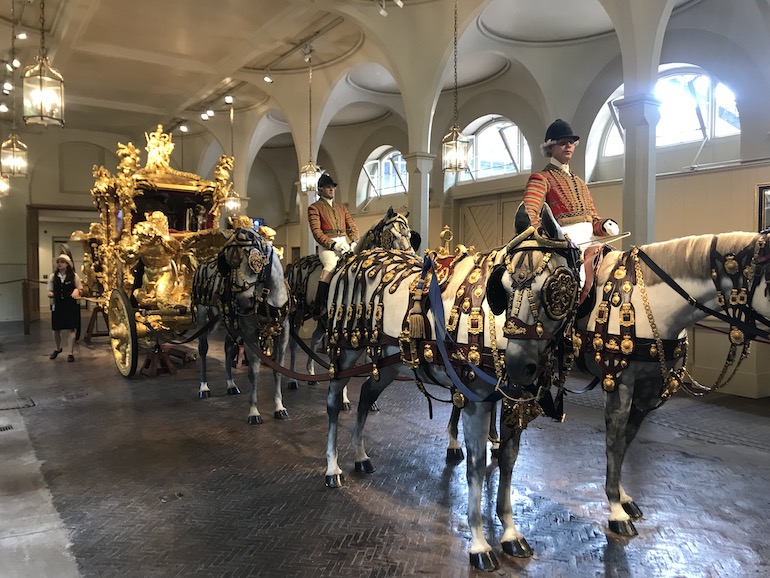
Gold State Coach at Royal Mews in London. Photo Credit: © Edwin Lerner.
Diamond Jubilee State Coach
More modern state coaches are fitted with heating and air-conditioning, electric windows, and hydraulic stabilisers. The most recently completed one is the Diamond Jubilee State Coach which was originally intended for the Queen’s eightieth birthday in 2006 but was not completed until 2010 and brought to London in 2014, the delay caused by funding issues.
The Diamond Jubilee Coach was not commissioned by the royal family and was built by the Australian coach builder Jim Frecklington on spec. However, it was purchased for the Royal Collection as a gift and is housed in the Royal Mews in London. The coach was first used officially at the State Opening of Parliament in 2014. It weighs 2.75 tons and is 18 feet (5.5 metres) long.
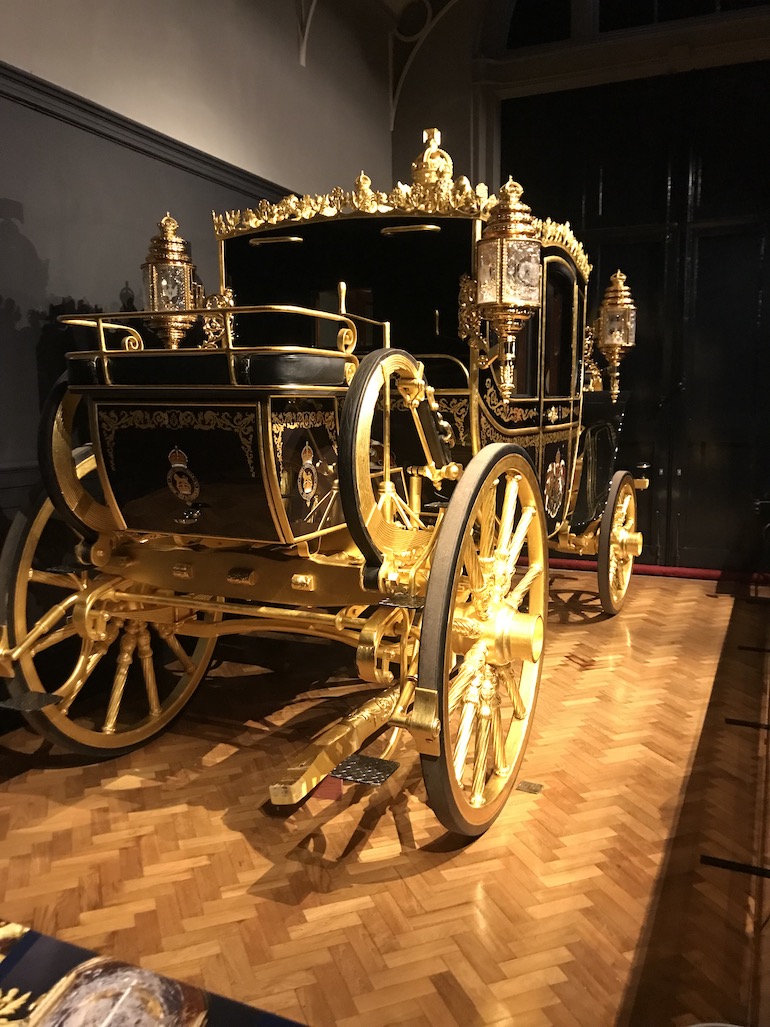
Diamond Jubilee Coach at Royal Mews in London. Photo Credit: © Edwin Lerner.
Like the Australian State Coach, which was given as a gift to the Queen by Australia on the occasion of its bicentenary in 1988, the Diamond Jubilee Coach needs six Windsor Grey horses to tow it on official occasions. The Australian Coach was on standby in case of rain at the Queen’s diamond jubilee parade but the weather was considered good enough for an open landau to be used by members of the royal family, who could be seen by the crowds.
The Glass Coach is also kept in the Royal Mews in London. This is a smaller coach used by members of the royal family for weddings and the parade to the Trooping of the Colour Ceremony, the official celebration of the monarch’s birthday, which always takes place in June regardless of when the actual birthday occurs. It was used to convey Lady Diana Spencer and Princess Margaret to their wedding ceremonies at Saint Paul’s Cathedral and Westminster Abbey.
Lady Diana indicated in advance of her wedding ceremony at Saint Paul’s Cathedral that she would like to arrive late to the wedding, which was traditional for women getting married. The coachman in charge of the journey, however, was a stickler for punctuality and always prided himself on arriving exactly on time for royal engagements. He would practice and rehearse the journey, always allowing for traffic. He was horrified at the idea of arriving late for any royal appointment. In the end, a compromise was reached and the coach arrived just thirty seconds late for the wedding, which he felt nobody (except the bride) would notice.
The Royal Mews in London also houses around thirty cars used by members of the royal family. Five are official state cars (which do not have a number plate) and are used when members of the family are performing official duties throughout Great Britain. Two of these are Bentleys and three are Rolls Royces. All have doors that open in the opposite direction to most cars in order to allow a more dignified exit from the vehicle. The Queen’s personal car can be identified by the royal pennant flying from it and a mascot at the front. This shows Saint George and the Dragon and was a wedding present from her late husband Prince Philip.
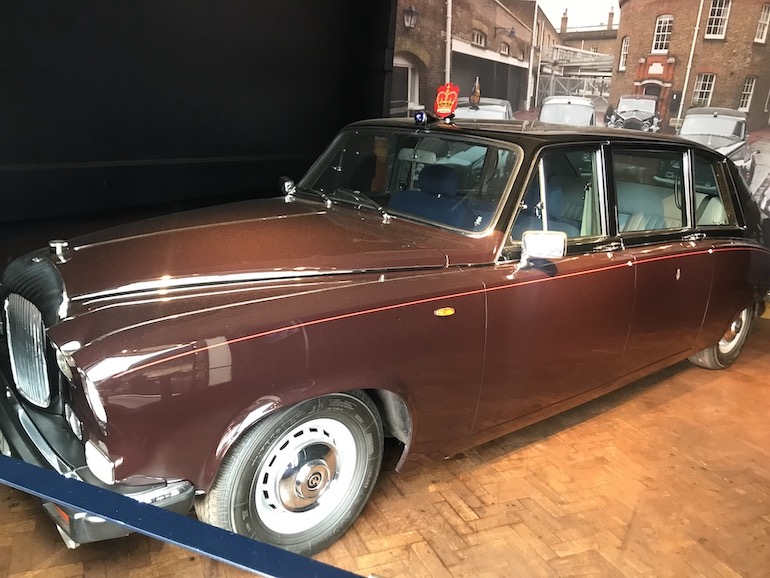 Daimler at Royal Mews in London. Photo Credit: © Edwin Lerner.
Daimler at Royal Mews in London. Photo Credit: © Edwin Lerner.
The Royal Mews in London is home for the horses that are needed to tow the carriages and staff there have to muck out the stables every morning to get rid of the dung that accumulates overnight. The dung used to be tossed into a large pile in the middle of the Mews courtyard but Queen Victoria objected to the smell it created and gave instructions that it should be removed. It is now mixed with garden waste and used as compost in the Buckingham Palace gardens. Victoria evidently had a sensitive nose because she also complained to the Duke of Wellington, who was Constable of the Tower of London between 1826 and 1852, that the moat around the Tower was smelly. He promptly had it drained and grass planted there.
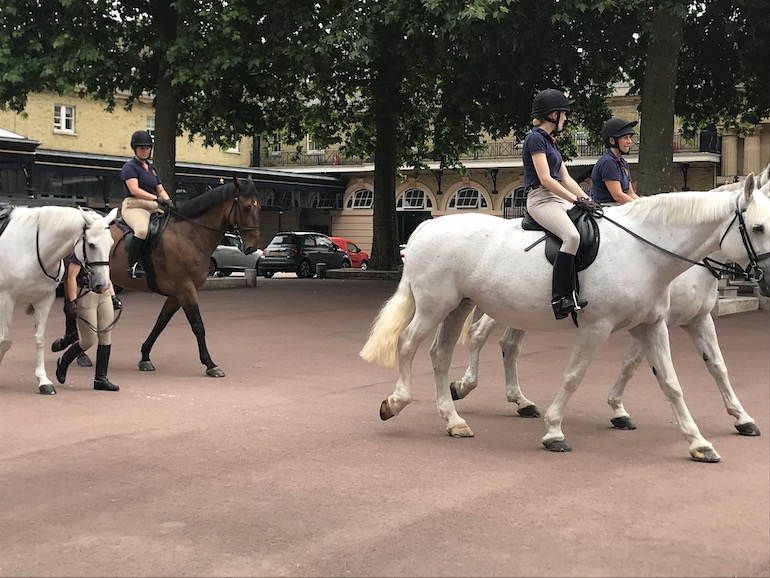
Horses at Royal Mews in London. Photo Credit: © Edwin Lerner.
Both the Royal Mews and the Queen’s Gallery are open Thursday to Monday and closed on Tuesday and Wednesday. Check their website for details.
London’s Blue Badge Tourist Guides accompany visitors to all royal residences throughout the year via our Royal London Tour.



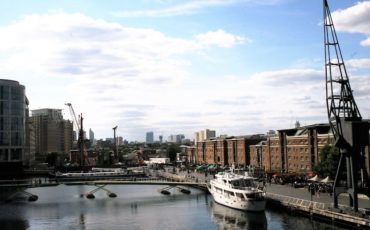
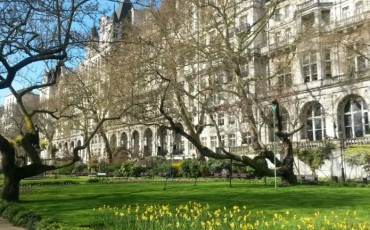


Leave a Reply